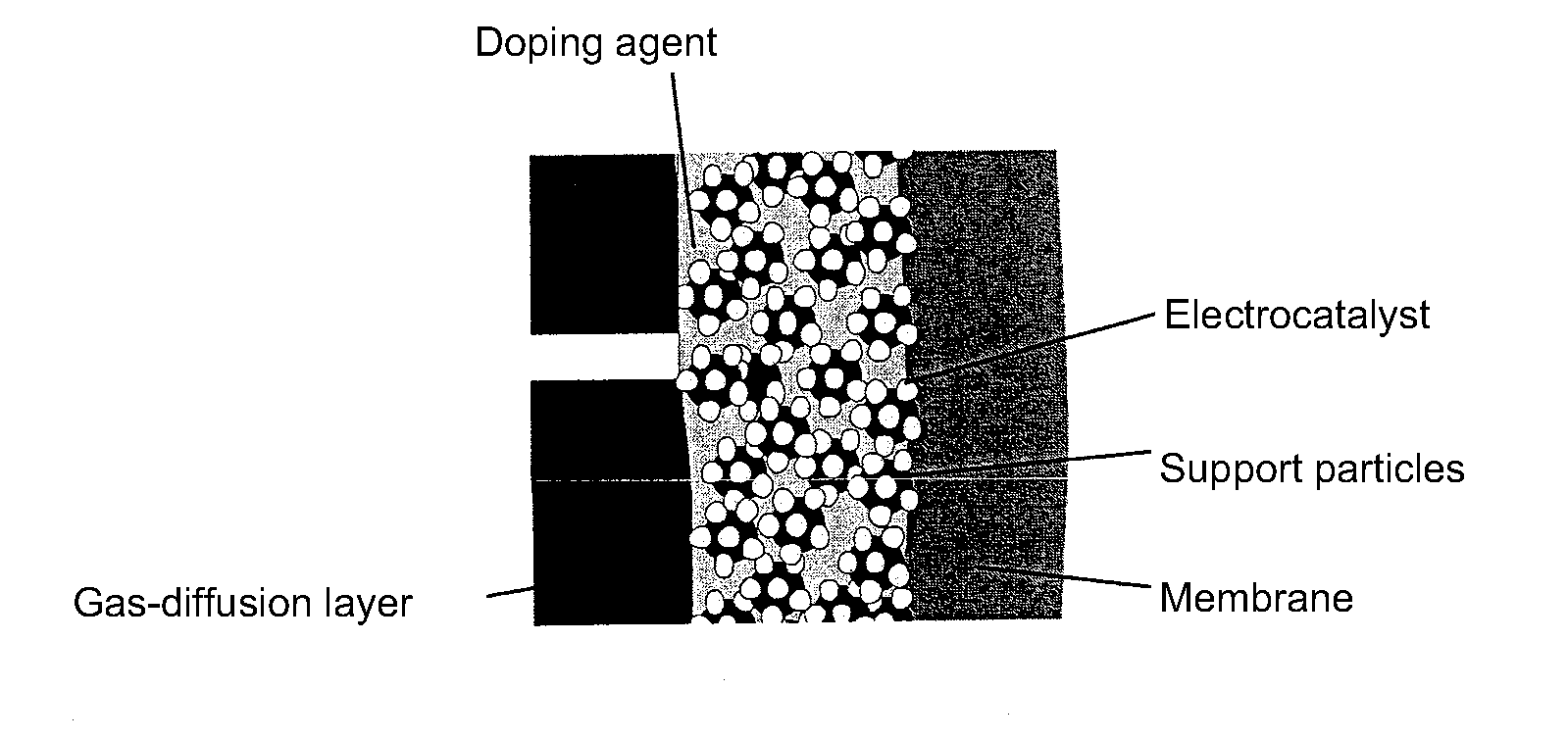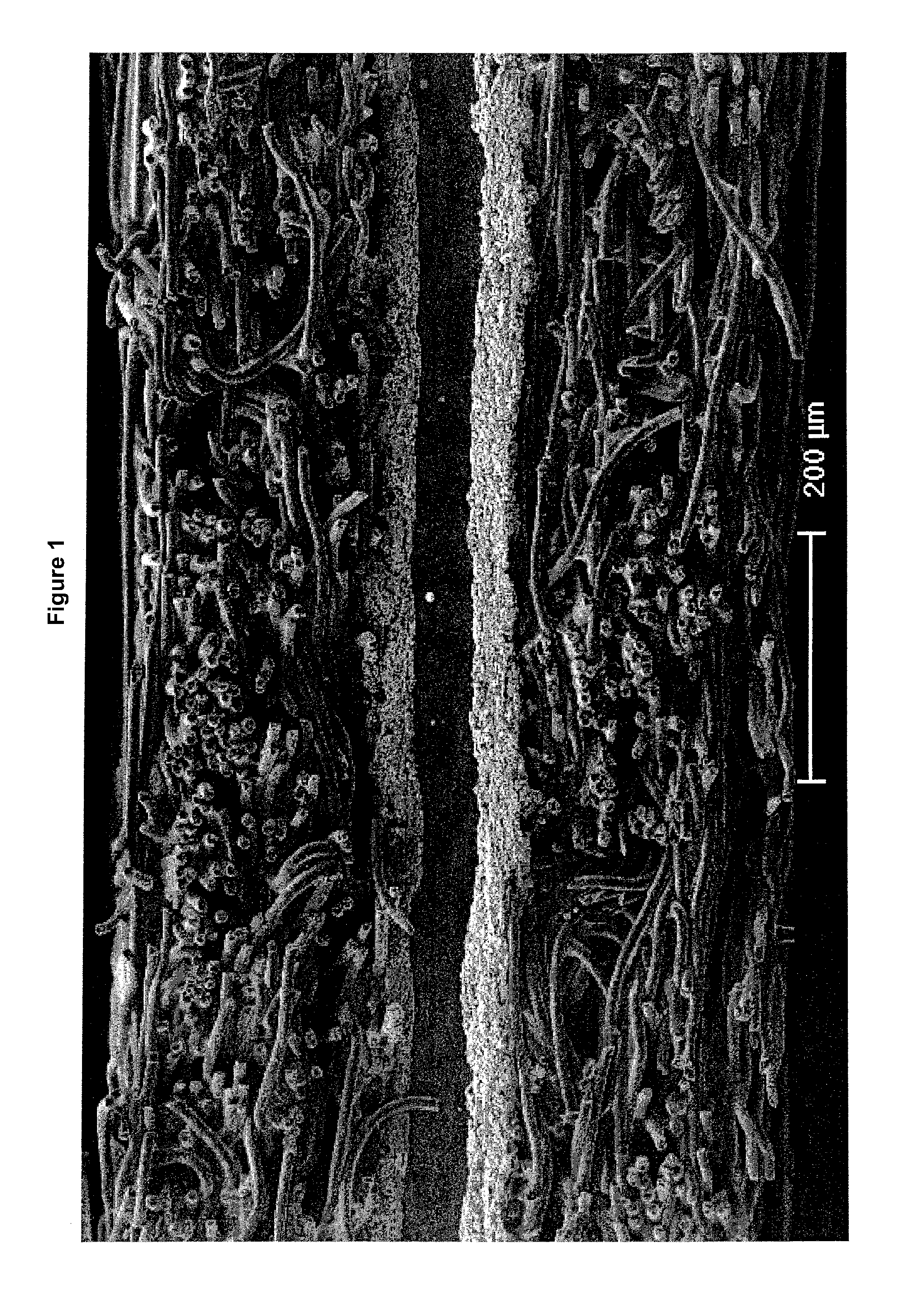Gas diffusion electrodes comprising functionalised nanoparticles
a technology of functionalised nanoparticles and gas diffusion electrodes, which is applied in the manufacture of final products, cell components, electrochemical generators, etc., can solve the problems of phosphoric acid also used as electrode electrolyte, partial inactivation of catalyst centers, and unsuitability of nafion® as proton-conducting material, etc., to achieve improved power density and long-term stability, good adhesion, and durable high stability
- Summary
- Abstract
- Description
- Claims
- Application Information
AI Technical Summary
Benefits of technology
Problems solved by technology
Method used
Image
Examples
example 1
Production of a Microgel Dispersion
[0159]The microgel dispersion used for production of the inventive gas-diffusion electrodes was produced by means of emulsion polymerization in conformity with Example 1, pp. 29-30 of DE 102007011424.0. To achieve the emulsion polymerization, 3.93 kg water was introduced into a 6-liter glass reactor with stirrer and purged with a stream of nitrogen. Now 24.2 g Mersolat® H95 (sodium salt of a mixture of long-chain C16-C18 alkylsulfonates, Lanxess Deutschland GmbH) as part of the total Mersolat amount of 26.3 g was introduced into the water in the water-containing receiver and dissolved. Then 1000 g of a mixture consisting of 88.5 wt % styrene (98%, from KMF Labor Handels GmbH), 10 wt % sodium styrenesulfonate (90%, from Fluka, product number 94904) as well as 1.5% trimethylolpropane trimethacrylate (90%, from Aldrich, product number: 2468-0) together with 0.08 g 4-methoxyphenol (Arcos Organics, article No. 126001000, 99%) was introduced into the rea...
example 2
Production of Gas-Diffusion Electrodes for the Anode
[0160]100 g of a catalyst-coated support material (40% Pt / Vulcan XC-72, Cabot Co.) was suspended in 405.9 g water until complete wetting of the catalyst. To this mixture there was added 26 g 60% polytetrafluoroethylene (PTFE) suspension in water (TF5032N, Dyneon Co.), then the mixture was united with 405.9 g isopropanol and stirred at 9500 rpm for 40 minutes by means of an UltraTurrax ultrathorax stirrer (IKA T-25). The resulting suspension was printed by means of an inkjet system (EBS-1500, EBS Ink-Jet System Co.) at the center of a 50 cm2 square area of a polymer electrolyte membrane of polybenzimidazole (PBI) measuring 102.9 cm2. The membrane coated with the catalyst layer was dried for 2 hours at 120° C. in a stream of nitrogen. The finished membrane-anode composite had a platinum surface density of 0.48 mg / cm2 on the electrode side.
example 3
Production of Gas-Diffusion Electrodes for the Cathode with Nanoparticles
[0161]8.41 g of a catalyst-coated support material (40% Pt / Vulcan XC-72, Cabot Co.) was suspended in 38.06 g water until complete wetting of the catalyst. To this suspension there was added 0.90 g microgel dispersion (0.17 g nanoparticles in water, produced according to Example 1), then the mixture was united with 38.06 g isopropanol and stirred at 9500 rpm for 10 minutes by means of an UltraTurrax ultrathorax stirrer (IKA T-25). Using the finished suspension, a 50 cm2 square area was printed by means of an inkjet system (EBS-1500, EBS Ink-Jet System Co.) on a polyester film (Pütz Co., 100 μm) and placed on a 50 cm2 square section of a 200 μm thick gas-diffusion layer of type H2315 of the Freudenberg Co. The gas-diffusion layer coated with the catalyst layer was dried for 2 hours at 120° C. in a stream of nitrogen and the polyester film was peeled off. The finished gas-diffusion electrode had a microgel proport...
PUM
 Login to View More
Login to View More Abstract
Description
Claims
Application Information
 Login to View More
Login to View More - R&D
- Intellectual Property
- Life Sciences
- Materials
- Tech Scout
- Unparalleled Data Quality
- Higher Quality Content
- 60% Fewer Hallucinations
Browse by: Latest US Patents, China's latest patents, Technical Efficacy Thesaurus, Application Domain, Technology Topic, Popular Technical Reports.
© 2025 PatSnap. All rights reserved.Legal|Privacy policy|Modern Slavery Act Transparency Statement|Sitemap|About US| Contact US: help@patsnap.com



